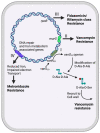Clostridioides difficile Infection: Diagnosis and Treatment Challenges
- PMID: 38392856
- PMCID: PMC10891949
- DOI: 10.3390/pathogens13020118
Clostridioides difficile Infection: Diagnosis and Treatment Challenges
Abstract
Clostridioides difficile is the most important cause of healthcare-associated diarrhea in the United States. The high incidence and recurrence rates of C. difficile infection (CDI), associated with high morbidity and mortality, pose a public health challenge. Although antibiotics targeting C. difficile bacteria are the first treatment choice, antibiotics also disrupt the indigenous gut flora and, therefore, create an environment that is favorable for recurrent CDI. The challenge of treating CDI is further exacerbated by the rise of antibiotic-resistant strains of C. difficile, placing it among the top five most urgent antibiotic resistance threats in the USA. The evolution of antibiotic resistance in C. difficile involves the acquisition of new resistance mechanisms, which can be shared among various bacterial species and different C. difficile strains within clinical and community settings. This review provides a summary of commonly used diagnostic tests and antibiotic treatment strategies for CDI. In addition, it discusses antibiotic treatment and its resistance mechanisms. This review aims to enhance our current understanding and pinpoint knowledge gaps in antimicrobial resistance mechanisms in C. difficile, with an emphasis on CDI therapies.
Keywords: Clostridioides difficile infection; cell cytotoxicity neutralization assay; drug-resistant pathogen; enzyme immunoassays; host immunity; nucleic acid amplification testing; recurrent C. difficile infection.
Conflict of interest statement
The authors declare no conflicts of interest. The authors assert that the research was conducted without any affiliations or financial interests that might be perceived as a potential conflict of interest.
Figures

References
-
- Centers for Disease Control and Prevention . 2021 Annual Report for the Emerging Infections Program for Clostridioides difficile Infection. Centers for Disease Control and Prevention; Atlanta, GA, USA: 2021.
Publication types
MeSH terms
Substances
Grants and funding
LinkOut - more resources
Full Text Sources
Medical

